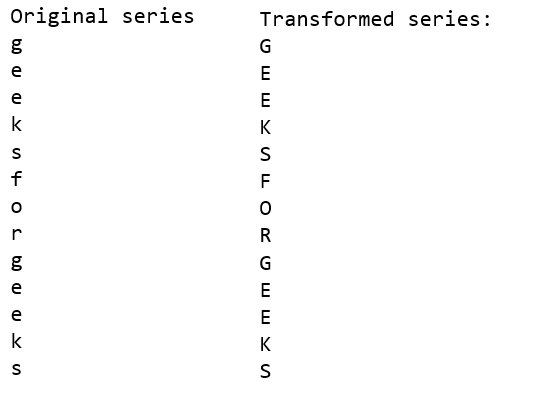Pandas 中 map、applymap 和 apply 方法的区别
Pandas 库广泛用于数据操作和分析。 map() 、 applymap()和apply()方法是 Pandas 库的方法。
applymap() method only works on a pandas dataframe where function is applied on every element individually.
apply() method can be applied both to series and dataframes where function can be applied both series and individual elements based on the type of function provided.
map() method only works on a pandas series where type of operation to be applied depends on argument passed as a function, dictionary or a list.
请注意,输出的类型完全取决于用作给定方法的参数的函数类型。
熊猫apply()方法:
此方法可用于 pandas 数据框和系列。作为参数传递的函数通常适用于行/列。下面的代码说明了apply()方法如何在 Pandas 数据帧上工作。
# Importing pandas library with an alias pd
import pandas as pd
# Dataframe generation
gfg_string = 'geeksforgeeks'
gfg_list = 5 * [pd.Series(list(gfg_string))]
gfg_df = pd.DataFrame(data = gfg_list)
print("Original dataframe:\n" + \
gfg_df.to_string(index = False,
header = False), end = '\n\n')
# Using apply method for sorting
# rows of characters present in
# the original dataframe
new_gfg_df = gfg_df.apply(lambda x:x.sort_values(), axis = 1)
print("Transformed dataframe:\n" + \
new_gfg_df.to_string(index = False,
header = False), end = '\n\n')
输出: 
下面的代码说明了如何在 Pandas 系列上apply()方法:
# Importing pandas library with an alias pd
import pandas as pd
# Series generation
gfg_string = 'geeksforgeeks'
gfg_series = pd.Series(list(gfg_string))
print("Original series\n" + \
gfg_series.to_string(index = False,
header = False), end = '\n\n')
# Using apply method for converting characters
# present in the original series
new_gfg_series = gfg_series.apply(str.upper)
print("Transformed series:\n" + \
new_gfg_series.to_string(index = False,
header = False), end = '\n\n')
输出: 
熊猫applymap()方法:
此方法可用于 pandas 数据帧。作为参数传递的函数通常适用于数据框的元素applymap()通常用于元素操作。下面的代码说明了applymap方法如何在 pandas 数据帧上工作:
# Importing pandas library with an alias pd
import pandas as pd
# DataFrame generation
gfg_string = 'geeksforgeeks'
gfg_list = 5 * [pd.Series(list(gfg_string))]
gfg_df = pd.DataFrame(data = gfg_list)
print("Original dataframe:\n" + \
gfg_df.to_string(index = False,
header = False), end = '\n\n')
# Using applymap method for transforming
# characters into uppercase characters
# present in the original dataframe
new_gfg_df = gfg_df.applymap(str.upper)
print("Transformed dataframe:\n" + \
new_gfg_df.to_string(index = False,
header = False), end = '\n\n')
输出: 
熊猫map()方法:
此方法用于作为参数传递的系列函数、列表和字典。此方法通常用于映射来自具有相同列的两个系列的值。下面的代码说明了map方法如何在 pandas 系列上工作:
# Importing pandas library with an alias pd
import pandas as pd
# Series generation
gfg_string = 'geeksforgeeks'
gfg_series = pd.Series(list(gfg_string))
print("Original series\n" + \
gfg_series.to_string(index = False,
header = False), end = '\n\n')
# Using apply method for converting characters
# present in the original series
new_gfg_series = gfg_series.map(str.upper)
print("Transformed series:\n" + \
new_gfg_series.to_string(index = False,
header = False), end = '\n\n')
输出: 